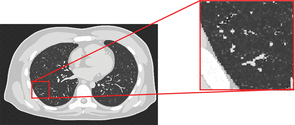Virtual Imaging Trials Can Improve CT and X-ray Use in COVID-19 Patients
Virtual simulation models can help identify the best ways to use different modalities to improve patient care during the pandemic.
CT scans and X-ray images can be safely tested and optimized with virtual imaging trials, newly published research shows.
In an article published ahead-of-print in the American Journal of Roentgenology, investigators from Duke University outlined how virtual imaging – using computational models to emulate imaging – can be used to improve care of patients with COVID-19. This virtual framework, they said, can shed light on how varying modalities can best be used during the outbreak.
“Virtual imaging trials are highly advantageous in that the same subjects can be imaged with different scanners and settings,” wrote the team led by Ehsan Abadi, Ph.D., assistant professor of radiology at Duke, “and the exact truth of the anatomic and physiologic features of the subjects are a priori known.”
Example of 4D extended cardiac-torso (XCAT) phantom developed at Duke University. B, Representative computational model shows lung stroma intraorgan structure of XCAT phantom that was developed using anatomically informed mathematic model. Inset shows enlarged view for better visibility of details and small structures. Courtesy: American Journal of Roentgenology

According to the team, these virtual trials, also called virtual clinical trials or in silico trials, emulate imaging experiments by combining validated imaging simulators with computational models of patients. With COVID-19 in particular, Abadi’s team said the goal is to use these trials to compare CT and X-ray methods and identify protocols that can improve screening and follow-up, as well as dose optimization, for patients infected with the virus.
Using 4D extension cardio-torso models developed at Duke to which they added abnormalities associated with COVID-19 that were pulled from 20 CT scans of actual patients infected with the virus, including ground-glass opacities and consolidation, the team created computational patients. They constructed three different simulation models that could be imaged with either a CT or X-ray simulation tool also developed at Duke.
Example of 4D extended cardiac-torso (XCAT) phantom developed at Duke University. C, Voxelized rendition (ground truth) of XCAT phantom highlights detailed model of lung parenchyma. Inset shows enlarged view for better visibility of details and small structures. Courtesy: American Journal of Roentgenology

Based on subjective feedback to their work, the team reported that the simulated abnormalities in the models were realistic in shape and texture. Consequently, they determined, these tools sets could be used effectively in virtual imaging trials that can comprehensively assess and compare quality and performance of imaging methods with COVID-19 infection.
In addition, they said, these models can also be used to optimize radiation and image quality for each modality, as well as train and evaluate machine-learning algorithms for particular diseases.
What is the Best Use of AI in CT Lung Cancer Screening?
April 18th 2025In comparison to radiologist assessment, the use of AI to pre-screen patients with low-dose CT lung cancer screening provided a 12 percent reduction in mean interpretation time with a slight increase in specificity and a slight decrease in the recall rate, according to new research.
Meta-Analysis Shows Merits of AI with CTA Detection of Coronary Artery Stenosis and Calcified Plaque
April 16th 2025Artificial intelligence demonstrated higher AUC, sensitivity, and specificity than radiologists for detecting coronary artery stenosis > 50 percent on computed tomography angiography (CTA), according to a new 17-study meta-analysis.
Can CT-Based AI Radiomics Enhance Prediction of Recurrence-Free Survival for Non-Metastatic ccRCC?
April 14th 2025In comparison to a model based on clinicopathological risk factors, a CT radiomics-based machine learning model offered greater than a 10 percent higher AUC for predicting five-year recurrence-free survival in patients with non-metastatic clear cell renal cell carcinoma (ccRCC).